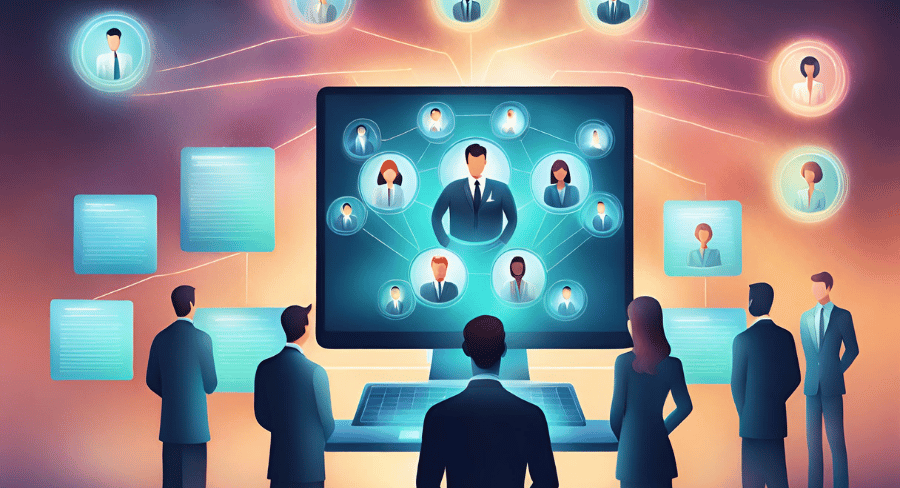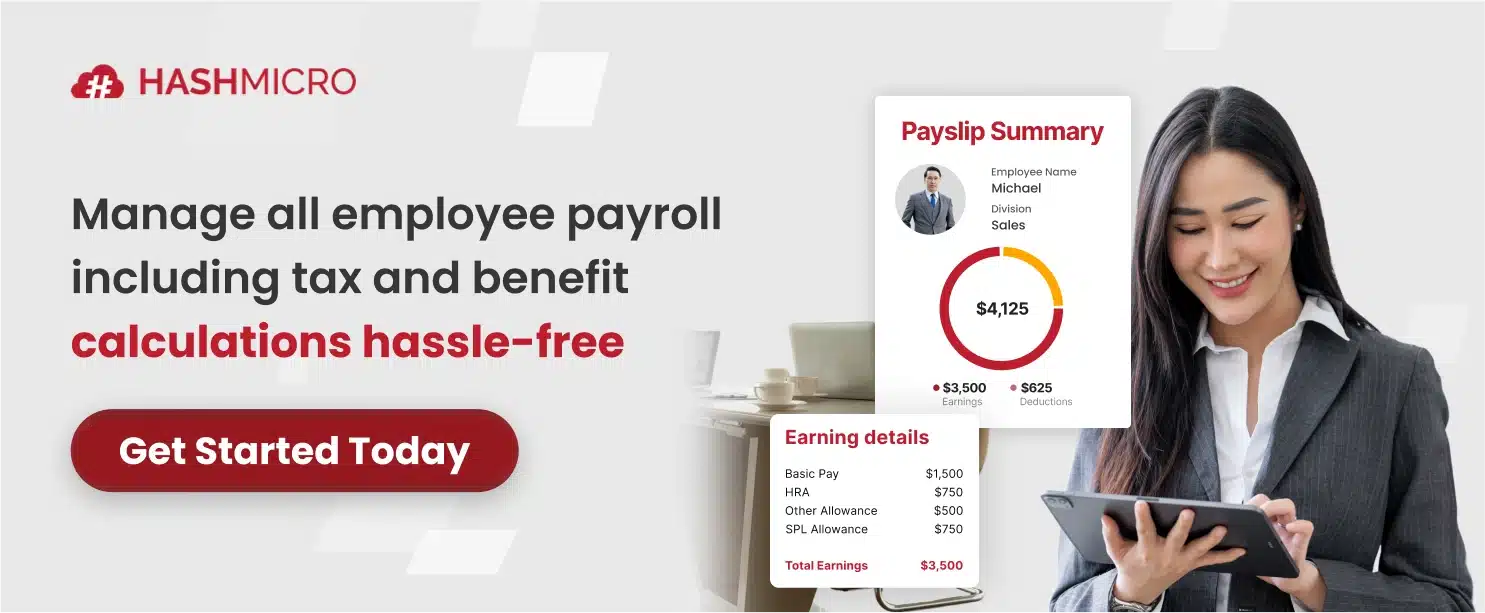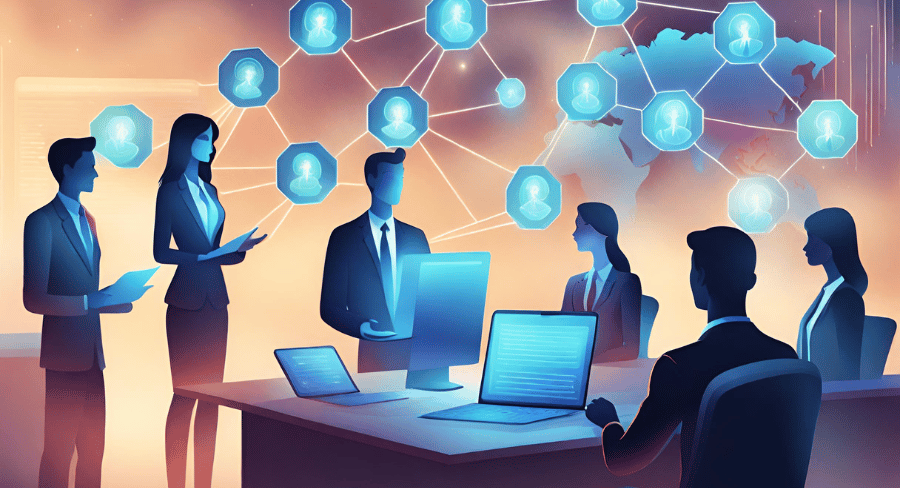A Human Resources Management System (HRMS) manages human resources and processes throughout the employee lifecycle. An HRMS helps a company understand its workers in a single integrated software.
Not only does the software help HR, but it also automates work usually done by staff, freeing them up to do more important work. This is how HRMS software helps companies increase efficiency and understand their employees.
This article will help you understand Human Resources Management Systems better by discussing their definition, function, benefits, and other explanations of the HRMS.
Table of Content:
Table of Content
Key Takeaways
|

What is Human Resources Management Systems?

Human Resource Management Systems (HRMS) encompass the comprehensive administration of essential HR areas within an organization.
These systems effectively oversee a company’s employee records, covering critical aspects of human resource management such as personnel management, payroll processing, leave management, employee benefits administration, handling employee claims, and facilitating performance appraisals.
In essence, HRMS serves as a centralized platform that integrates and manages various administrative functions to streamline and optimize human resource processes within a company.
A few of the many HR functions that the HRMS supports are recruitment, employee data management, benefits administration, payroll management, benefits administration, employee performance management, training, and competency tracking. With this system, HR can focus on more important and strategic work.
HR leaders and employees are the primary users, as they are responsible for compliance and performance reporting and oversee daily workforce operations. However, not just the HR department benefits.
Self-service for routine chores can empower managers and staff, which is an essential selling point for younger hires. Using an HRMS, executives can generate data on worker trends and their consequences for the company.
Given that HR-related charges are among the significant expenses made by a business, integration of the HRMS with the accounting system is essential for finance departments. Leading providers will go beyond basic accounting to help companies get more financial insights from HR data.
The Difference Between HRMS, HRIS, and HCM
HRIS stands for “Human Resources Information System.” Usually, companies use HRMS AND HRIS interchangeably. The origins of HRIS date back to the 1980s, when IT departments were known as Management Information System (MIS) departments.
With time, the computerization of HR information and procedures began to occur, and HRIS emerged as a derivative of MIS. After the HR management system’s technological growth beyond the storing of personnel records, HRIS is renamed HRMS.
So, what is the HRIS meaning in HRM or the distinction between a Human Resource Information System (HRIS) and a Human Resource Management System (HRMS)? Because the two systems are so closely related, most providers have combined them and use the terms interchangeably.
An HRIS has traditionally been used to describe a system that tracks static employee information such as social security number and name, whereas an HRMS focuses on aspects of managing employee functions such as performance, time off, and onboarding.
Human Capital Management (HCM) is an extension of HRIS and HRMS that encompasses a broader set of functions aimed at optimizing the value of an organization’s human capital.
While HRIS and HRMS focus on managing specific HR tasks and employee information, HCM is designed to manage and enhance the entire employee lifecycle. This includes recruitment, management, development, and optimization of employees to maximize their contribution towards organizational success.
6 Key Functions of HRMS Singapore
Before choosing the best HRMS for your company, there are several functions that you should pay attention to, which are:
1. Candidate management
Refers to job offers, how you promote your brand to the outside world, and current employees who may apply for internal jobs or make referrals. Essential for companies that prioritize the candidate experience, from applying to resume management to interview scheduling to making offers to onboarding.
2. Employee engagement
How an employee connects with leadership and coworkers is vital because engaged employees generate higher-quality work, adopt the company’s values, and execute its mission. The best HR software is often used to complete a training course, learn a new skill, build a career path, achieve recognition, or become a mentor.
3. Optimization
Using HRMS data to generate a future workforce vision is a selling point. It’s the HRMS’s least-used function. The actual usefulness of this function emerges during a merger or acquisition, economic swings, or executive departures.
Companies that optimize their personnel proactively are more change-resistant, retain more top talent, and have higher employee engagement.
4. Payroll
Calculating earnings from gross to net or net to gross, withholding certain deductions, and sending payments can be as ordinary as paying rent. Benefit elections and employee and employer charges are payroll functions.
Payroll services automate tax filing and deposits. Self-service tools let employees adjust elective deductions, direct deposit accounts, and tax withholdings without HR help.
5. Workforce management
HR teams oversee employee development, management evaluations, disciplinary actions, time and attendance, and a healthy and safe work environment. It includes pay, performance, learning, and incident recording.
HRMS performance management features, like goal tracking and continuous feedback, empower employees to proactively engage in their career development, enhancing job engagement and satisfaction.
6. Contingent workforce management
This relates to primary workforce management and is crucial for non-full-time organizations. Contractors, consultants, interns, and temporary workers supply specific skills and handle labor spikes.
The HRMS doesn’t entirely manage these relationships because contingent employees aren’t always on the payroll and aren’t eligible for benefits. However, their work contributes to company success, so tracking how many contingent employees are on board at any given time and the total costs are essential.
Human Resources Management System Features
HRMS feature sets vary widely with each provider, so each company should assess its choice carefully. Below are components of HRIS enterprise features a company must have.
- Benefits administration: Aids HR professionals in creating programs, configuring eligibility rules, and paying benefits providers. It also offers self-service open enrollment and benefits cost accounting.
- Centralized employee records: Provides a single repository for all personnel records: better reporting, cheaper compliance, and audit expenses.
- Learning management: Assists employees learn skills through course administration, curriculum development, testing, and certifications. Allows firms to track compliance training.
- Reporting and analytics: Run operational reports to track HR information, complete compliance reporting, establish KPIs to measure HR process performance, and embed HR metrics into financial dashboards for company-wide analysis, planning, and decision-making. Consider ad-hoc report creation.
- Rewards: Calculate salaries, hourly wages, variable bonuses, overtime, sales commissions, shift differentials, and merit increases while withholding regulatory and voluntary deductions. This feature set may include matching retirement account contributions or mobile phone reimbursements.
- Talent acquisition: Recruiters can build career pages on the company website and intranet, integrate open positions with job boards, create job requisitions and descriptions, manage resumes, track applicants through the recruiting process, manage roles, perform background checks, and others.
- Talent management: Performance reviews, goal management, and competency and skills tests help HR professionals develop and evaluate personnel.
- Time and attendance: Integrate timecards with payroll and projects, process time off, and manage balance.
- User interface: The entire workforce can use an HRMS with a user-friendly interface. Employee and manager self-service, localization, mobile apps, personalized dashboards, role-based access controls, notifications, and workflow automation keep employees engaged and HR or IT inquiries low.
- Workforce planning: Allows planning and budgeting for present and future personnel costs and measuring versus actual outlays. Identifies talent gaps, creates succession plans, and prioritizes recruitment.
Tips for Choosing an HRMS Software in Singapore
You need to have the best HR Software to get your company’s best results. Selecting software will not be complicated if you follow these five steps:
Identify needs
Understand your company’s demands before selecting software. Selecting the finest HR software for your firm requires a comprehensive view of your HR department’s demands.
Research Vendors
Learn the best HR software for your needs. Keep track of the tools that work well throughout and decide which factors you’re willing to compromise on.
Make a shortlist
Deepen your search to find the best HR software. Your investigation undoubtedly revealed numerous standout vendors.
Test-drive your shortlisted vendors
Use free trials and demos to test each tool’s UI, UX, and functionality. Test it on a limited scale, noting any restrictions or problems. As many staff as possible should provide input. As end-users, they can point up flaws you missed. If the product you like doesn’t offer a free trial, try it monthly before committing to annual billing.
Implement and onboard
Make sure your HR software is user-friendly. Poor implementation and integration are why organizations don’t get ROI on software investments. Change management is essential. Employees must comprehend how your new software helps them (e.g., saves them time/approves PTO requests faster) and how to utilize it.
Another important factor to count into is the prices, be sure to check that the provider gives a pricing scheme that is best suited for your needs, like Hashmicro, which you can check by clicking the banner below!
HRMS Benefits for Businesses in Singapore
Having all of your personnel information in one place is the primary benefit of Human Resources Management Systems. This reduces compliance risks, gives decision-makers access to extensive data sets, encourages employee engagement, increases the productivity of HR experts, and streamlines HR operations.
Besides that, here are other benefits of using an HRMS for your business.
Better, deeper insights
With an HRMS, all data is in one, more secure bucket giving you better and faster decisions result. It’s also key to workforce planning and analytics when a corporation compares its current staff to future demands based on business objectives.
Some major benefits include identifying and fixing skills gaps before they impair productivity, codifying succession plans, and controlling labor expenses by studying how overtime or double-time payments affect financial performance.
Moreover, leveraging AI-driven HR analytics, HRMS transforms the approach to talent management, offering deeper insights and smarter decision-making.
Improved employee engagement
HRMS helps HR leaders develop and retain people. An HRMS can develop training curriculums, customize learning programs and career trajectories, and set up mentorships.
Process Efficiency and culture of self-service
Responding to inquiries or administering significant programs like benefits enrollment or performance reviews can take up to 40% of an HR professional’s time each week. Many employees would instead do this work themselves.
HR can set up a knowledge repository in an HRMS so individuals can find answers to frequently asked issues. With employee self-service in HRMS, employees enjoy greater autonomy in managing their profiles, enhancing engagement and efficiency.
Lower back-end overhead
The centralized nature of an HRMS requires less hardware, data center space, and IT and development personnel resources for maintenance, support, and training. This rationalizes IT spending for HR technology, reduces help desk staff, and enhances HR team satisfaction.
Faster recruiting
Other HR priorities include attracting top personnel and making your company comfortable for your workers. Candidate experience has been largely overlooked because it’s hard to obtain insight into job searches when postings occur outside the firm.
An HRMS connects recruiters and candidates electronically through job boards and mobile apps, making the process more pleasurable and efficient. However, there’s still the option to build a job board and spread the word about it to other companies.
Improves employee data security
Employee data is personal and only people with interest are allowed to access it. HRM systems enable HR managers to control who can access information in the system, resulting in a small risk of data theft.
The Importance of HRMS
In the digital age, companies are increasingly turning to ERP systems to streamline their HR processes and enhance overall efficiency. Explore strategies for optimizing HR processes with HRMS, leveraging technology to streamline and enhance all aspects of human resource management.
Besides the benefits stated above, there are still several importances of ERP implementation in HR departments. In the following discussion, we will delve into the importance of ERP human resource management, exploring how it can transform HR practices and contribute to a company’s growth.
1. Centralized database
In traditional human resource management approaches, employee data is often scattered across various systems and physical documents. This decentralized storage leads to challenges in accessing and managing accurate and up-to-date information.
However, an ERP system for human resource management addresses this issue by providing a centralized database that serves as a single source of truth for all employee-related data.
By consolidating employee information such as personal details, employment history, performance records, training records, and benefits data into a unified database, the ERP system ensures data consistency, accuracy, and security.
HR staff can access and update employee records in real-time, reducing the reliance on manual paperwork and minimizing the risk of errors or duplications.
The centralized database aspect of an ERP system also facilitates efficient data retrieval and analysis. HR staff can quickly search and retrieve relevant employee information, such as qualifications, certifications, or performance evaluations, saving valuable time and effort.
This easy access to comprehensive employee data empowers HR staff to make informed decisions and respond promptly to employee queries or management requests.
2. Recruitment system
One of the key importance of an ERP system for human resource management lies in its ability to centralize and automate the recruitment process. Manual recruitment can be time-consuming, prone to errors, and often result in a fragmented recruitment process.
However, an ERP system transforms this by providing a dedicated recruitment system that streamlines and automates these processes.
The recruitment system within the ERP system modules offers a centralized platform for managing job postings and applications. HR staff can create and publish job vacancies across various platforms, including the company’s website or external job boards, directly from the ERP system.
Candidates can then apply for positions through an online application portal, where their information is captured and stored within the system. With an ERP system’s recruitment system, HR staff can also easily manage the candidate pipeline.
Resumes and applications are automatically parsed using resume parser and stored within the ERP system, allowing recruiters to quickly search and filter through candidate profiles based on specific criteria, such as qualifications, experience, or skills. This saves significant time and effort in manually reviewing and shortlisting candidates.
3. Training and development
The training and development module within an ERP system offers a centralized platform for managing all aspects of employee learning. HR staff can easily identify training needs based on performance and create training programs directly within the system.
This centralization ensures that training initiatives are aligned with the company’s strategic goals and individual employee development plans.
With an ERP system’s training and development module, employees can access a comprehensive catalog of training programs or courses available within the organization.
They can enroll in courses, view training materials, and track their progress, all through a self-service portal within the ERP system. This empowers employees to take ownership of their learning and development journey.
Moreover, the training and development module within an ERP system automates the administrative aspects of training management.
HR staff can schedule training sessions, send automated notifications to employees, and track attendance and completion records, all within the system. So, it also eliminates the need for manual record-keeping and reduces administrative burden.
4. Time tracking
ERP system offers a centralized platform for employees to log their work hours and attendance. Employees can easily record their clock-in and clock-out times, breaks, or any other time-related information directly within the system.
Certainly, this eliminates the need for manual timesheets and reduces the administrative burden on both employees and HR staff.
With an ERP system’s time tracking module, accuracy in recording work hours is significantly improved. The system can integrate with biometric devices, swipe cards, or other time-tracking tools, ensuring precise and reliable time data.
This reduces the risk of errors, buddy punching, or fraudulent time entries, promoting fairness and accountability in the workplace. Moreover, the time tracking module provides real-time visibility into employee attendance and work hours.
This ERP module can easily monitor employee attendance, track overtime or absences, and generate accurate timesheets for payroll processing. This eliminates the need for manual calculations or reconciliation and ensures that employees are compensated correctly for their time worked.
It also facilitates efficient management of leave and absence. Employees can request time off within the system, which can be automatically routed for approval based on predefined workflows. HR staff can track and manage employee leave balances, track leave usage, and generate reports for better workforce planning and resource allocation.
5. Regulation compliance
An ERP system for human resource management holds significant importance when it comes to ensuring compliance with regulations and laws governing the workforce.
With its specialized functionalities for regulation compliance, an ERP system provides companies with the tools and capabilities to meet legal obligations, mitigate risks, and maintain a compliant HR environment.
Simplifying HR compliance, the automated systems within HRMS efficiently navigate the complexities of labor laws and regulations. It serves as a repository for documentation and guidelines related to legal requirements, ensuring that HR staff have easy access to relevant information.
This centralization helps maintain consistency and ensures that compliance efforts are aligned with the company’s strategic objectives. Additionally, it can help companies manage compliance with employment and labor regulations.
It can assist in tracking and enforcing policies related to minimum wage, working hours, overtime, leave entitlements, and employee benefits. The system can automatically calculate and monitor adherence to these regulations, providing alerts and notifications when thresholds are exceeded or rules are violated.
Why Your Company Needs HRMS
HRMS is a digital assistant that does tedious work for HR by combining many linked HR operations onto a single platform. That way, HR specialists may focus on more strategic work.
HRMS does not only give perks to HR but also to executives, everyday managers, and staff. Besides saving time, the HRMS also saves expenses in the company, which they can use for more important matters.
HashMicro’s HRM System is a software that consists of every HR tool you need. This system can calculate salary and taxes, manage leave and attendance, expense claims, and other operations to make your company more efficient.
Our system consists of a basic and advanced HRM, which you can choose depending on your company’s needs. Start HashMicro’s Human Resource Management System demo now.
Catch the action! Try the free demo right away

FAQ About Human Resources Management Systems
-
What is an HRMS, and how does it differ from HRIS?
An HRMS (Human Resources Management System) is a software solution that integrates multiple HR functions and processes into a centralized platform. It encompasses a broader range of functions compared to HRIS (Human Resources Information System), which traditionally focuses on tracking static employee information. HRMS handles various HR tasks such as recruitment, payroll, performance management, and more.
-
What are the key benefits of implementing an HRMS in an organization?
Implementing an HRMS offers several advantages, including streamlined HR processes, improved data accuracy, enhanced employee engagement, better decision-making through data-driven insights, cost savings through process automation, and increased compliance with regulations.
-
How do I choose the right HRMS for my company’s needs?
Selecting the right HRMS involves assessing your company’s specific requirements. Consider factors like the size of your organization, the functionalities needed (e.g., payroll, recruitment, performance management), user-friendliness, integration capabilities with existing systems, vendor support, and scalability. It’s crucial to align the chosen HRMS with your company’s long-term goals.
-
What are the essential features or modules typically included in an HRMS?
HRMS platforms generally include modules for employee data management, payroll processing, recruitment and onboarding, performance management, learning and development, time and attendance tracking, benefits administration, and compliance management. These features collectively support various HR functions within an organization.
-
How does an HRMS contribute to improving employee engagement and productivity?
An HRMS enhances employee engagement by providing self-service portals for employees to manage their information, access training materials, request time off, and more. Additionally, it streamlines processes, reduces administrative burdens, enables transparent communication, and supports performance management, creating a more engaging work environment that ultimately boosts productivity.

























































